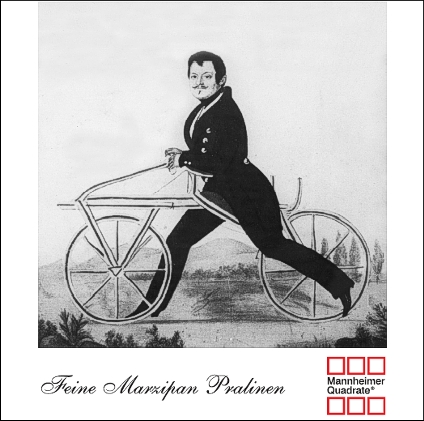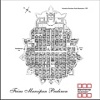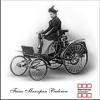Freiherr Carl Friedrich von Drais (1785 - 1845) 

Baron Carl Friedrich von Drais lived in Mannheim from 1811 to 1845.

He was far ahead of his time. On June 12, 1817, he invented the „steerable running cycle“, also known as „running machine“ or „draisine“, and which is considered to be the forerunner of today’s bicycle.
On that day, Baron Carl Friedrich von Drais undertook his first documented cycling tour, at a speed of around 15 kilometers per hour, from Mannheim to Schwetzingen. The destination was the Schwetzinger Relaishaus, a former mail station, which is part of Mannheim-Rheinau today. A replica of the „steerable running cycle“ used then, is still on exhibit in the Reiß-Engelhorn Museum in Mannheim. In that same year, Baron Carl Friedrich von Drais was appointed an honorary member of the scientific societies and professor of mechanics; he received an „inventor’s annuity“ for his ingenious idea and for his achievement. His patent for the running machine was granted by the Grand Duchy of Baden on January 30, 1818 and in France on December 5, 1818. Reproductions followed in the USA, England, Italy and even in the Indian city of Calcutta.
The inventor (he designed, among other things, a pressure cooker and a typewriter) was, however, not able to find a manufacturer with any appreciation for his „running cycle“. Despite its safe and fast means of transportation, his invention was considered to be „useless“ for a long period of time. But the reason for this evaluation was, even then, of a politically motivated nature. Means of transportation (known as mobilities) of that age were horse and carriage or ships. Other means of transportation, such as the „running cycle“ were simply prohibited! Those who were caught using this type of transportation were heavily fined. Although the Drais cycles were thereafter built throughout the world, even in Calcutta, their use was banned by way of „prohibition and punishment“ (1819). A so-called driving ban was imposed! The reason for this was the world-wide anxiety that the emerging running cycle might create competition for the horse-drawn cabs and vehicles in the existing poor economic situation of the time which had already led to an abundance of crop failures and famines.
It took quite a while and a series of continuous improvements and technical modifications, until his invention developed into the bicycle that we know today. In 1896, legal attorney Dr. Friedrich Engelhorn (son of the founder of BASF) and engineer Otto Boehringer (from the pharmaceutical branch of the Boehringer family) founded the „Drais Works Ltd.“ in Mannheim-Waldhof.
Baron Carl Friedrich von Drais led a very flamboyant life in both the business and political arenas as well as privately. There is not enough space here to put the history and the life career of this great inventor to paper. It would be worthwhile to study the facets of his life. Ultimately, they attest to the life of the people in this day and age and portray all of the bright and down sides of life at that time, the events of which are often amazing and sometimes even absolutely incredible.
Source:
Automobility, „Carl Drais and the Incredible Beginnings“, Hans-Erhard
Lessing, MAXIME Publishing House, Maxi Kutschera, Leipzig, 2003
Vers. 3.1




